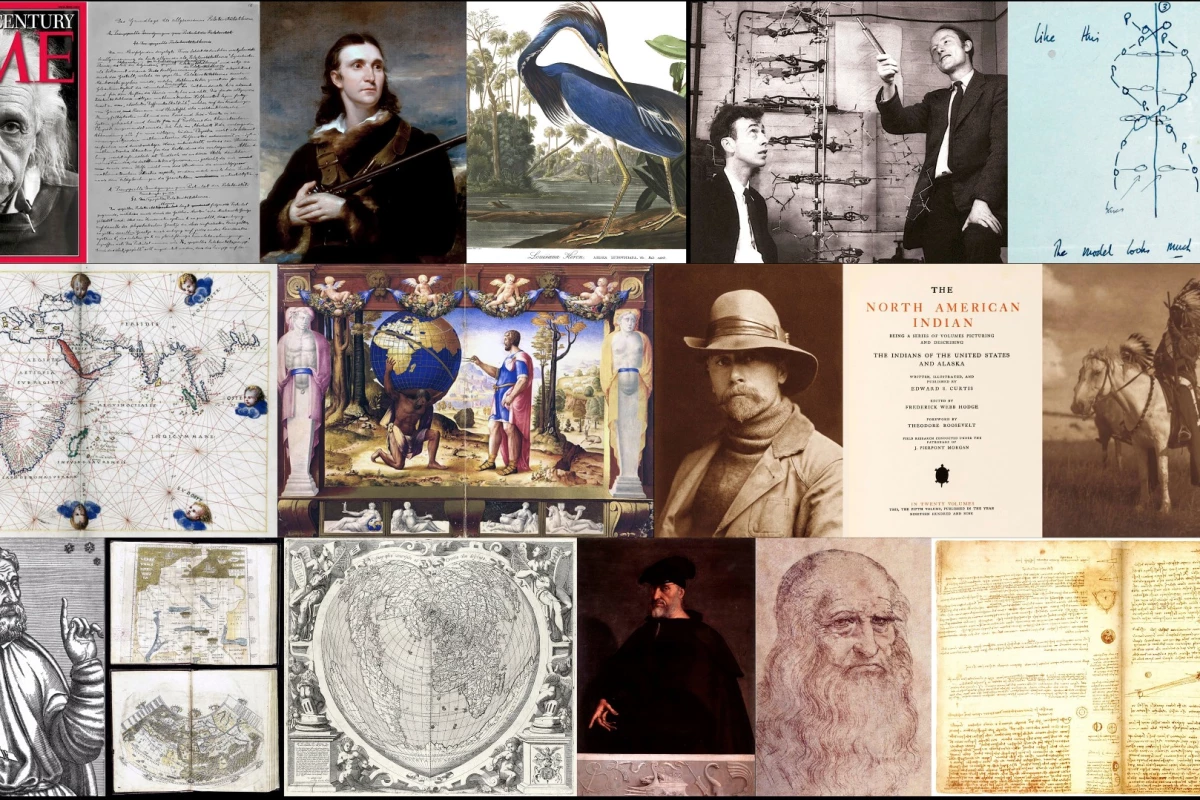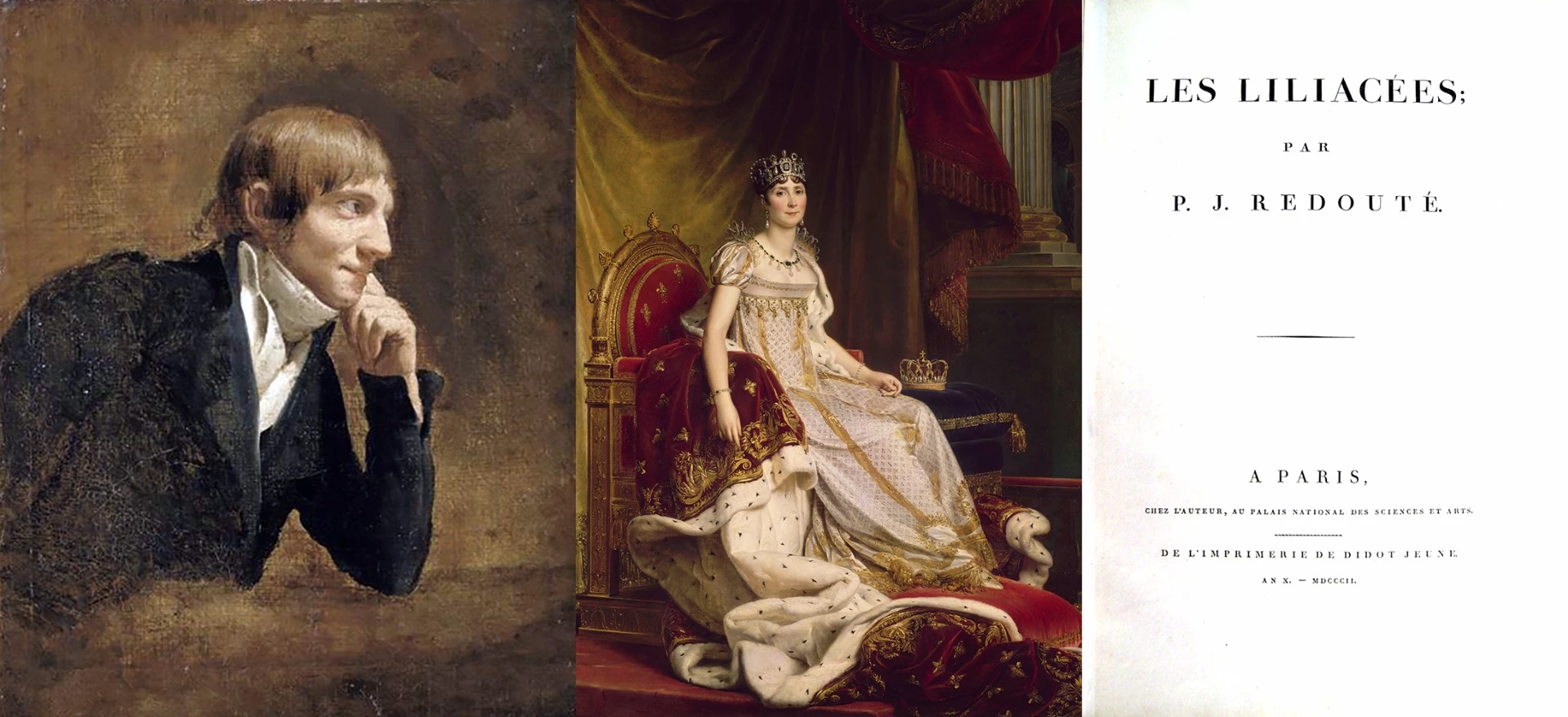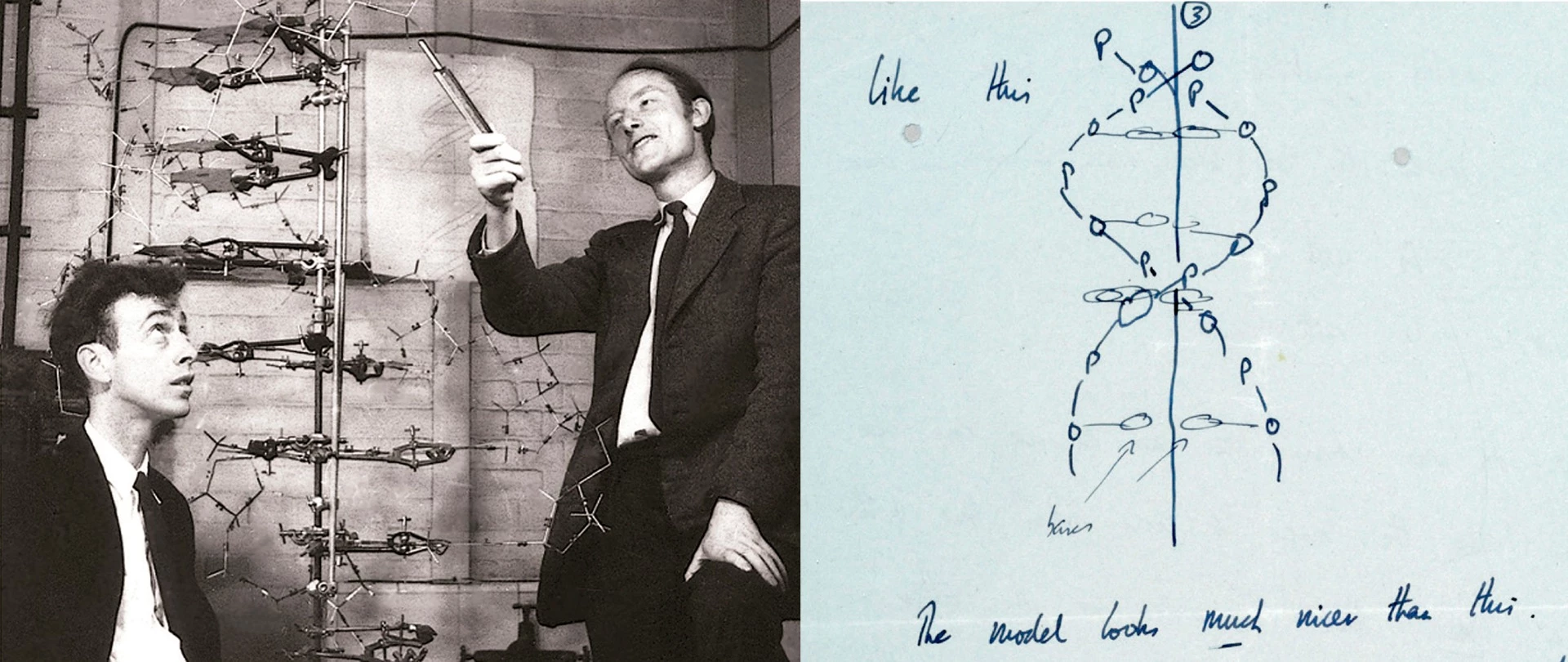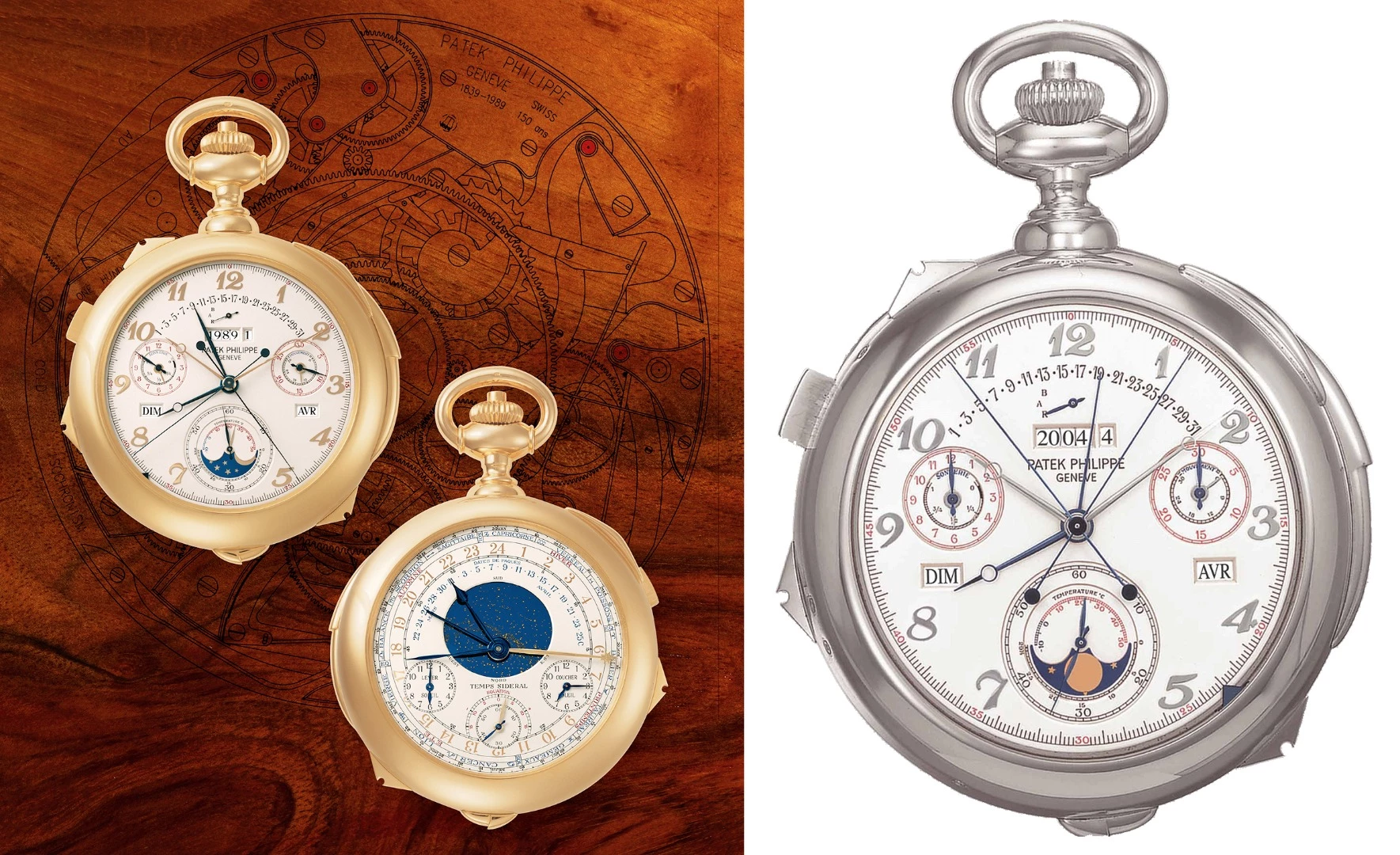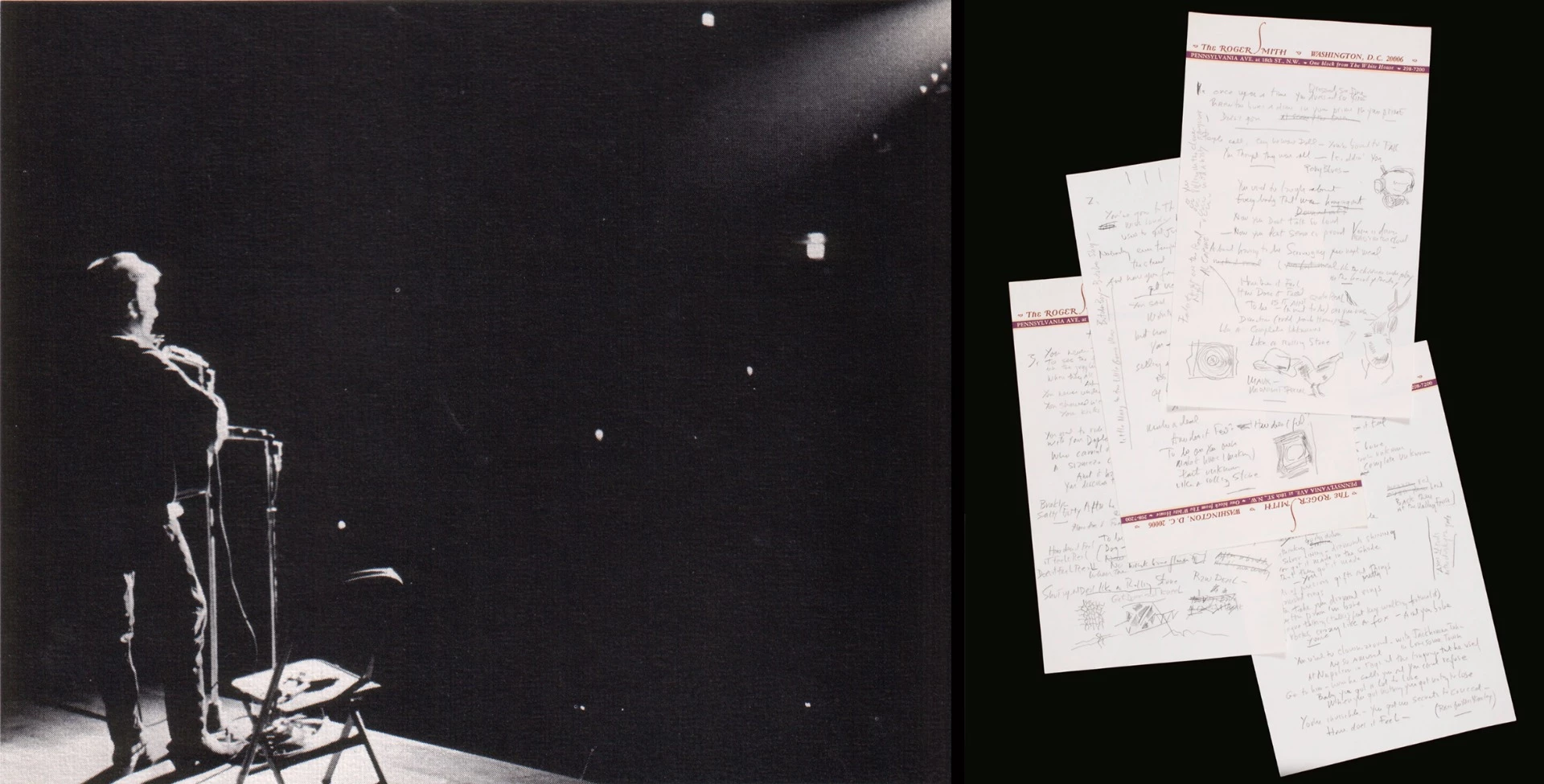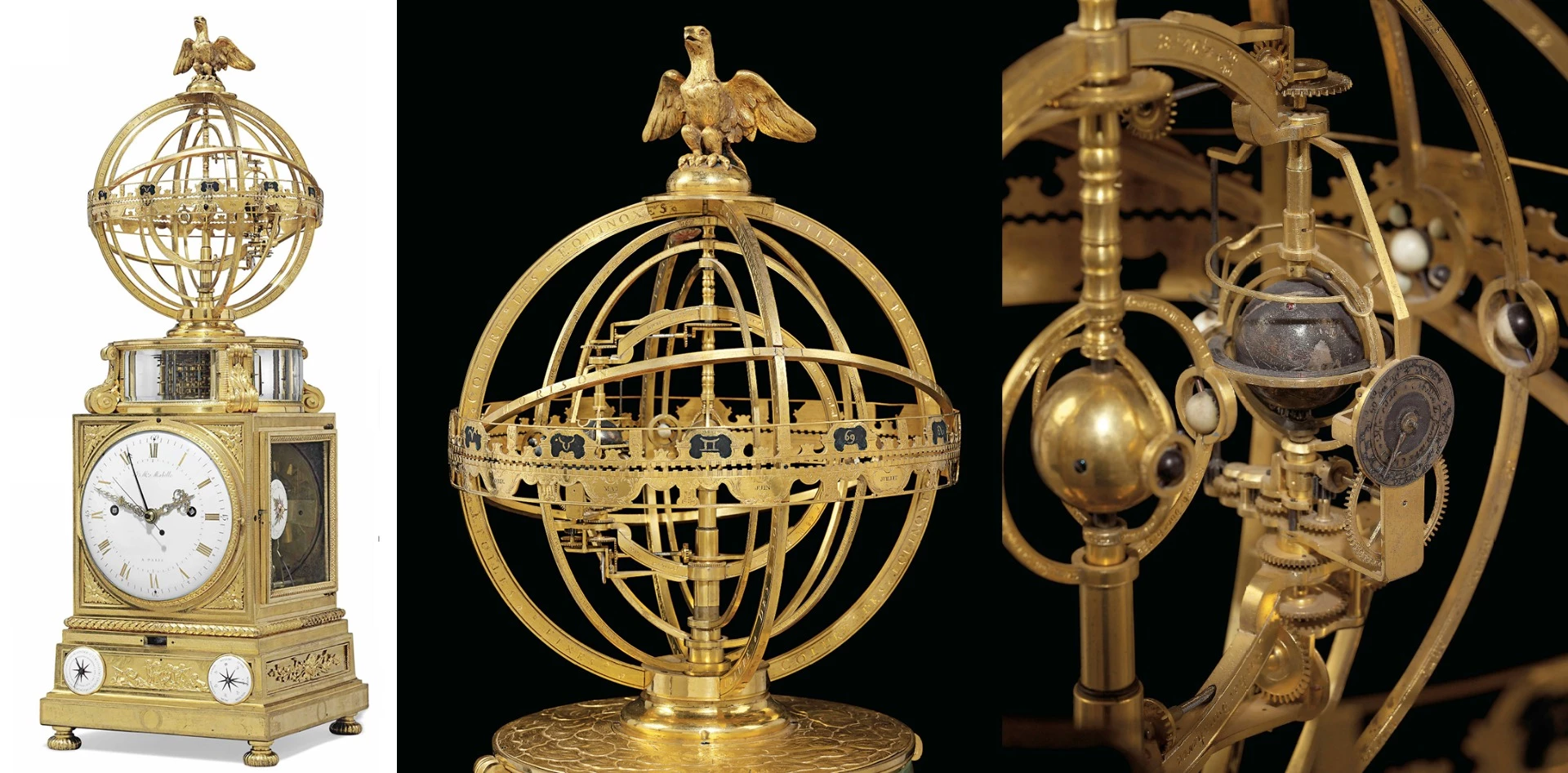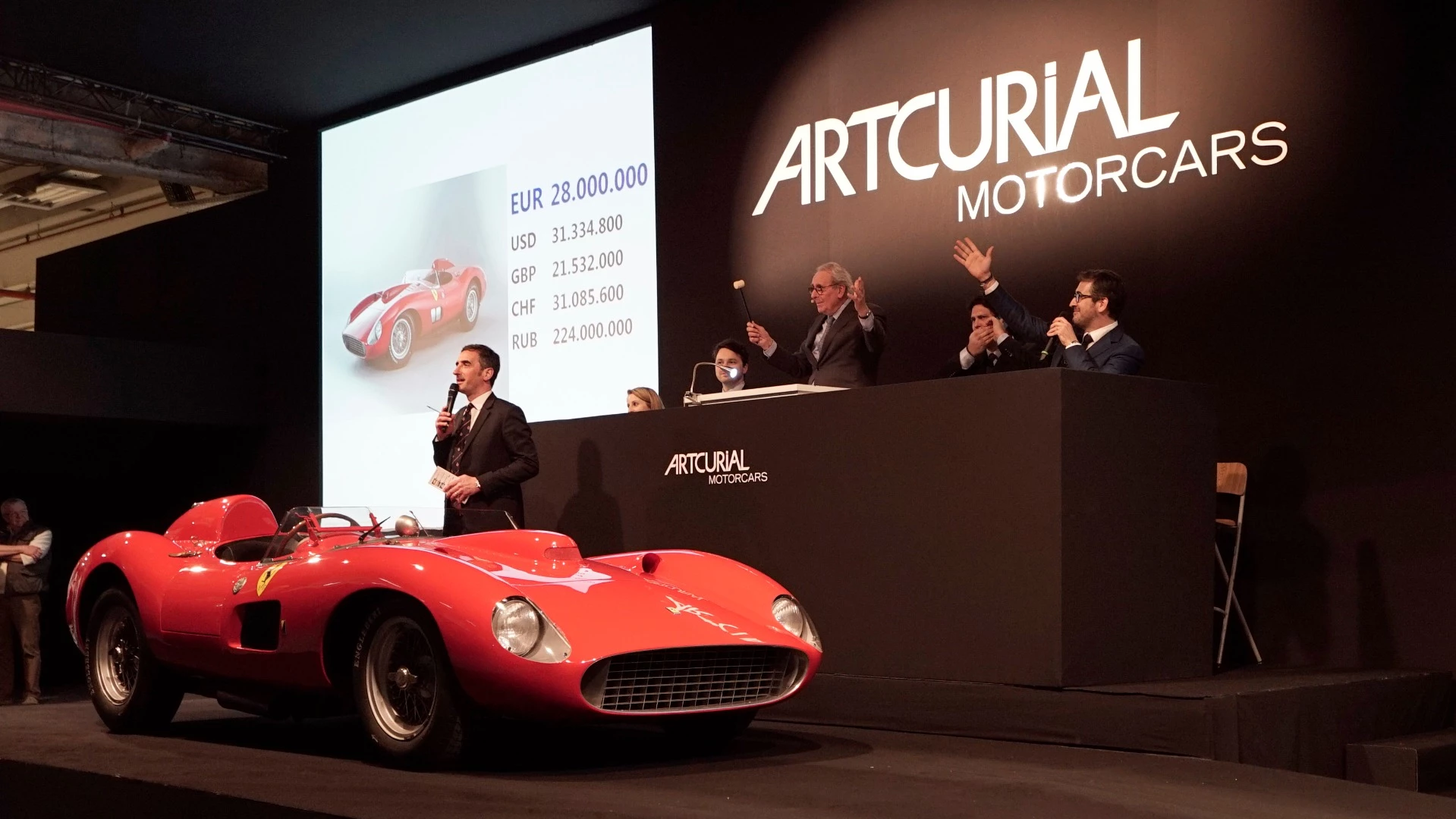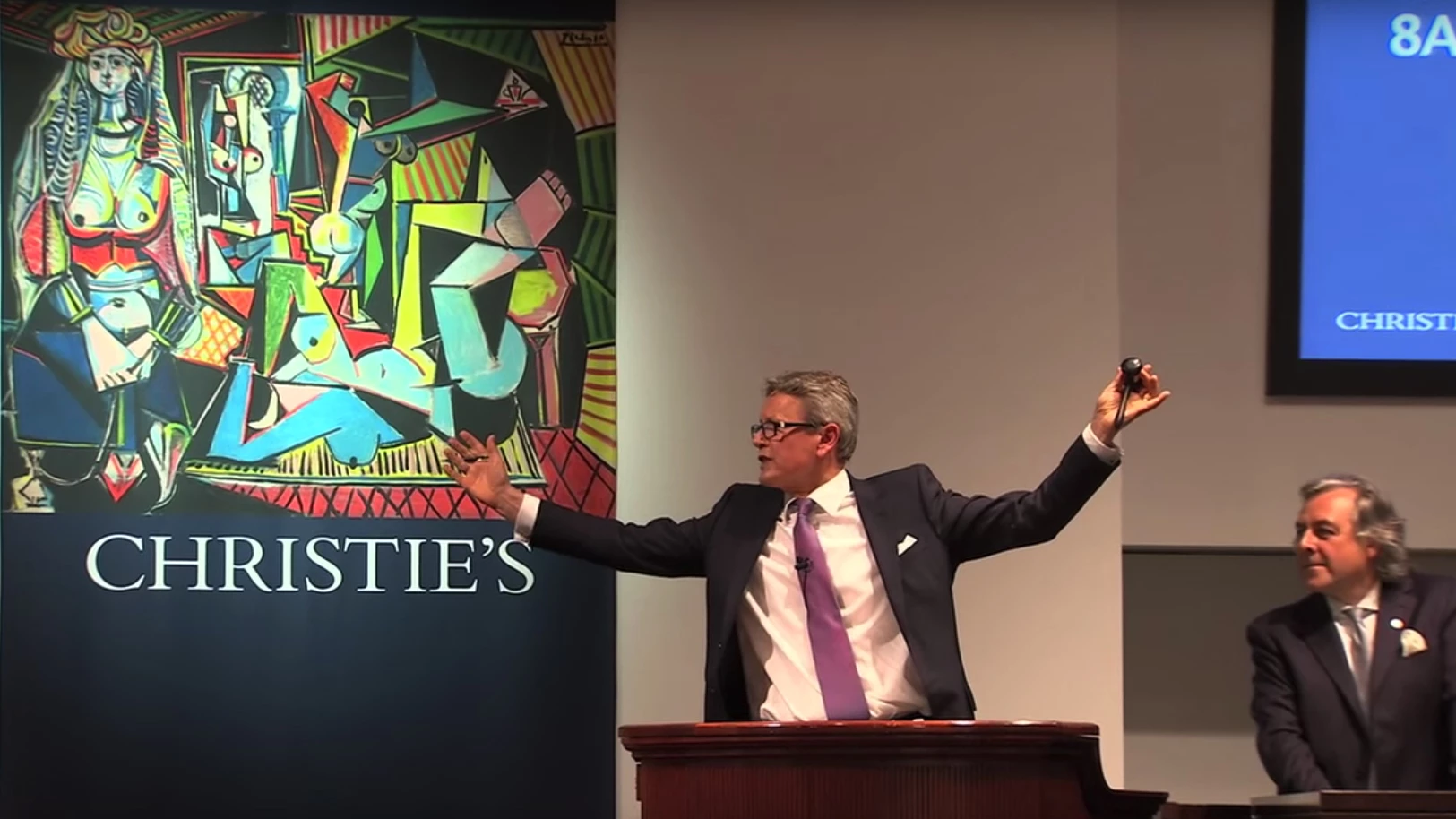UPDATED January 13, 2018 This is the final installment in our six part series exploring the most valuable scientific documents and manuscripts ever sold at auction. The introduction to the marketplace is the first part of the series, the second (numbers 50-41), third (numbers 40-31), fourth (numbers 30-21) and fifth (numbers 20-11) parts are already published.
In the real world, money seems like the most important variable in almost every equation, and it's the only readily available metric to compare the societal value of disparate objects.
By framing our list in the context of similar prices paid, we can compare societal perceptions of value for these scientific documents with the autograph manuscript of otherwise unrelated objects such as an autograph manuscript of Beethoven's Ninth, or Muhammad Ali's boxing gloves, Babe Ruth's baseball bat, Fangio's Silver Arrow, the Maltese Falcon, Eric Clapton's Blackie guitar ... or Marilyn Monroe's Seven Year Itch dress, the frock in which Julie Andrews sang Do-Ray-Mi, Audrey Hepburn's little black dress from Breakfast at Tiffany's or Judy Garland's ruby red slippers from The Wizard of Oz.
We'll be adding to this scientific manuscripts listing over time, updating it as more documents sell at auction and eventually publishing a much deeper list. Our research can currently see what we think is the vast majority of the top 250 scientific documents and manuscripts, but it's a work in progress so we've concentrated on the top 50 for now, and will expand to fully document humanity's scientific heritage as circumstances allow. This research hasn't previously been undertaken, so we're keen to make it as accurate and comprehensive as possible.
The full list to 250th place is a joy to behold, as all of the great scientists seem to have grabbed a spot. In many ways, it's the all-star team of scientific discovery and advancement and there can be no quarrel about who gets a guernsey because there's a simple selection criteria - the price that the global audience is prepared to pay.
As we uncovered new caches of historical auction listings based on newspaper reports, we realized that as the depth grew, most of the significant scientific advances in history were in there and began forecasting who would eventually appear on the list once it got deep enough. This enabled us to work the problem from a different angle, finding that the likes of Charles Darwin and Alexander Humboldt, who are notable absentees in the top 50, had indeed been recognized by the market within the top 150. The prices achieved might have been compromised by inflation, by the state of the marketplace at the time of the sale, the condition or completeness of what had survived the ravages of time and many other factors but the auction block is still the most equitable judge of merit we have.
It also became obvious that the timing of the landmark scientific contributions to the global knowledge pool can be too recent for historical perspective to be recognized - historical perspective is hard to judge at or near the time it happens.
Due to the miraculously rapid advancement of technology and understanding in the last few decades, we haven't realized that many figures of equal importance to Newton, Copernicus and Da Vinci are alive today - James Watson, Bill Gates, Vint Cerf, Tim Berners-Lee, Steve Wozniak et. al. have all contributed to a better world on a monumental scale and will unquestionably all be anointed into the Pantheon of Science.
Where's the top 50 scientific instruments listing?
We've listed the most significant scientific instruments in each item's addendum (entitled "Items that have sold for a similar price") because the more we tried to frame a set of rules for an equivalent top 50 scientific instruments, the more we struggled with a definition that works.
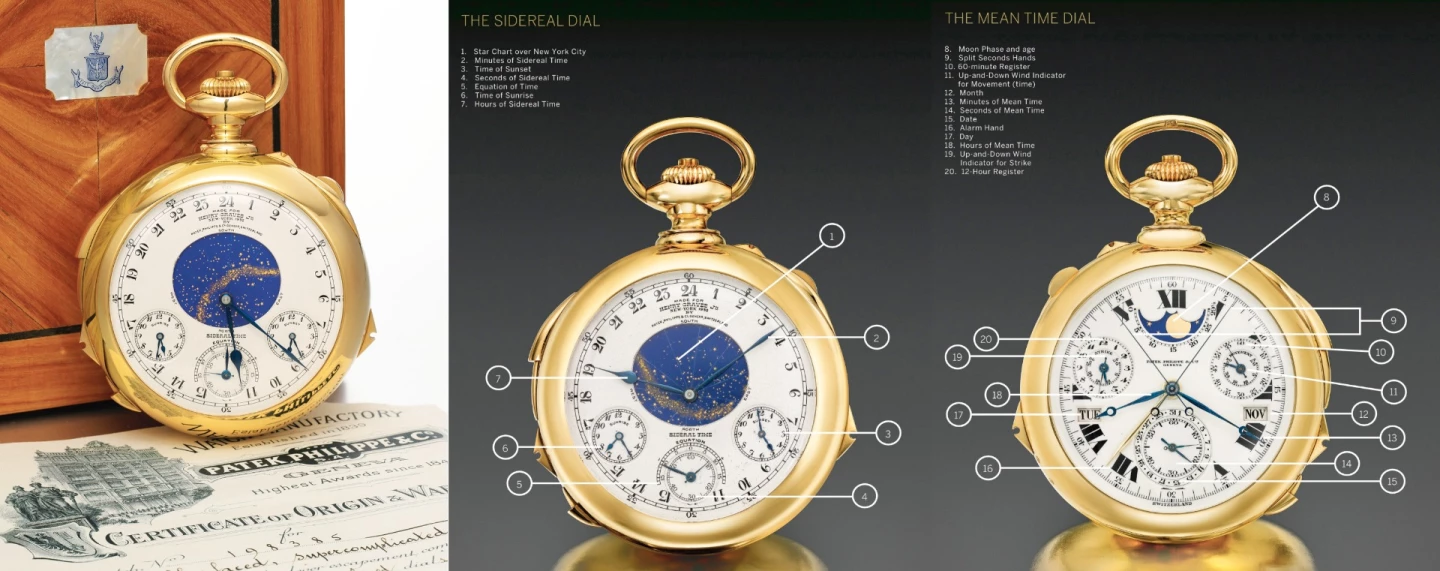
Judged by the "intent" of its creation, the 1933 Patek Philippe Graves Supercomplication Pocket Watch at the bottom of this listing was sold for a similar price to Leonardo Da Vinci's "Leicester Codex", but the result may have been little more than a game of one-upsmanship played by two fabulously wealthy individuals, and it was never really intended as a scientific instrument, nor was it used as one. It is however, a scientific instrument of extraordinary beauty and exquisitely accurate function.

Also failing the "intent" criteria is the Silesian parcel-gilt statuette of the Greek God Chronos supporting an Armillary Sphere that sold for $994,402 (€781,000) at Christie's Yves Saint Laurent estate sale in 2009. It was created in 1630 with the intent of being a work of art, but includes a working scientific instrument.As an aside, that same auction featured parts of what would certainly be one of the most valuable clocks of all time, even if it might not be a scientific instrument. The sale of two bronze fountainheads from an elaborate water clock stolen from the palace of the Chinese Qianlong Emperor in the mid-eighteenth century saw them fetch €14,000,000 (US$15.5 million) each, but the sale caused an international incident and it all fell through thanks to Government intervention. Given the original water clock once included many more identical bronze fountainheads, it would no doubt be worth a King's ransom if it were ever reconstructed.

If we're not counting watches created by business moguls as a hobby, the most expensive scientific apparatus we think qualifies in all respects is the pair of Murad III globes auctioned by Christie's (London) in October, 1991. The pair of gilt-metal globes (one terrestrial and one celestial) were once owned by Sultan Murad III (1546 – 1595) of the Ottoman Empire (1299-1922). Apart from being a global figure of significance (numerous envoys and letters were exchanged between Murad III and Elizabeth I of England discussing a military alliance which might have changed the shape of the world), he was also an avid scientist and military technologist. His refinement in the use of gunpowder continued a family tradition which included the taking of Constantinople with the biggest cannons the world had seen. Murad's globes may have been fit for the leader of a caliphate, but they were state-of-the art scientific instruments for the study of the heavens at the time and the Belgian workshop of Gerardus Mercator produced them. The globes were sold for $1,778,486 (£1,023,000) at a Christie's (London) auction in October, 1991.

Another that spanned the gap between art and scientific instrument was this Louis XVI Ormolu Striking Table Clock, which has a calendar, moonphase, equation of time and terrestrial "sphere mouvante". It was created in Paris circa 1775 and sold at a Christies (London) auction in 2015 for $926,440 (£602,500).
So rather than create a definitive listing (which remains a work in progress) of the most valuable scientific instruments, we've included significant prices achieved by globes, armillary spheres, astrolabes and clocks in the subtext, where we cite the similar auction prices of objects from other genres alongside the relevant scientific document.
In a world where every person perceives the societal value of objects differently, auction prices offer a metric by which to compare the significance of otherwise unrelated objects.
10 - The Portolan Atlas of the World by Battista Agnese

Price: $2,770,500
Created: circa 1546
Auctioned: Christie's (New York), April, 2012
Significance: Battista Agnese (c. 1500 – 1564) was a cartographer from the Republic of Genoa, who worked in the Venetian Republic. Agnese was the first cartographer to chart Marcos de Niza's American discoveries (1531-39), as well as those of Francisco de Ulloa (1539-40). It is believed that this is one of just 72 manuscript portolan atlases by him and his workshop that are extant. They were produced as expensive collectors' objects, often for presentation. It is these atlases which first presented on any maps the peninsula of lower California and the Vermillion Sea, the information of the discoveries of Francisco de Ulloa, who explored the Gulf of California in 1539-40 and provided the place names seen within.
9 - The North American Indian by Edward S. Curtis
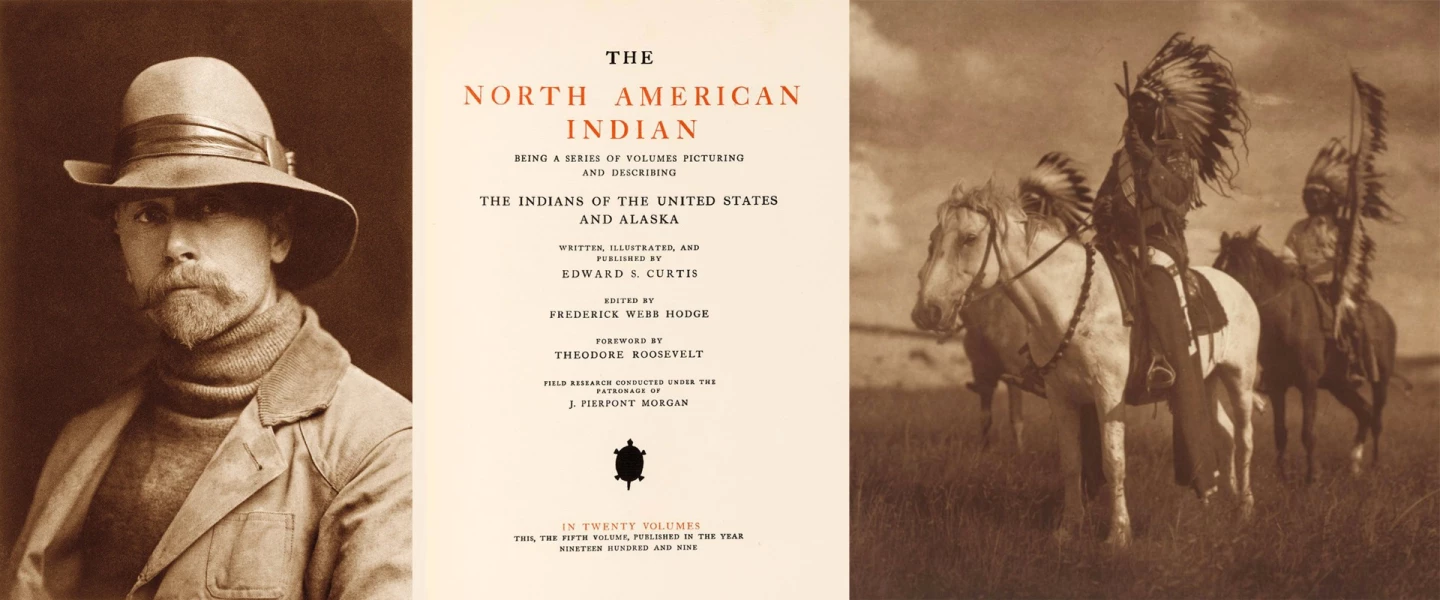
Price: $2,882,500
Estimate: $1,000,000 – $1,500,000
Created: Photography 1885 onwards, publishing 1907 to 1929.
Auctioned: Christie's (New York), April, 2012
Significance: The North American Indian was produced in 40 volumes between 1907 and 1930 by Edward S. Curtis (1868-1952) was one of the most expensive undertakings in the history of book production and one of the most comprehensive ethnographic records of any aboriginal people. According to author and critic A.D. Coleman, it is "an absolutely unmatched masterpiece of visual anthropology, and one of the most thorough, extensive and profound photograph works of all time."
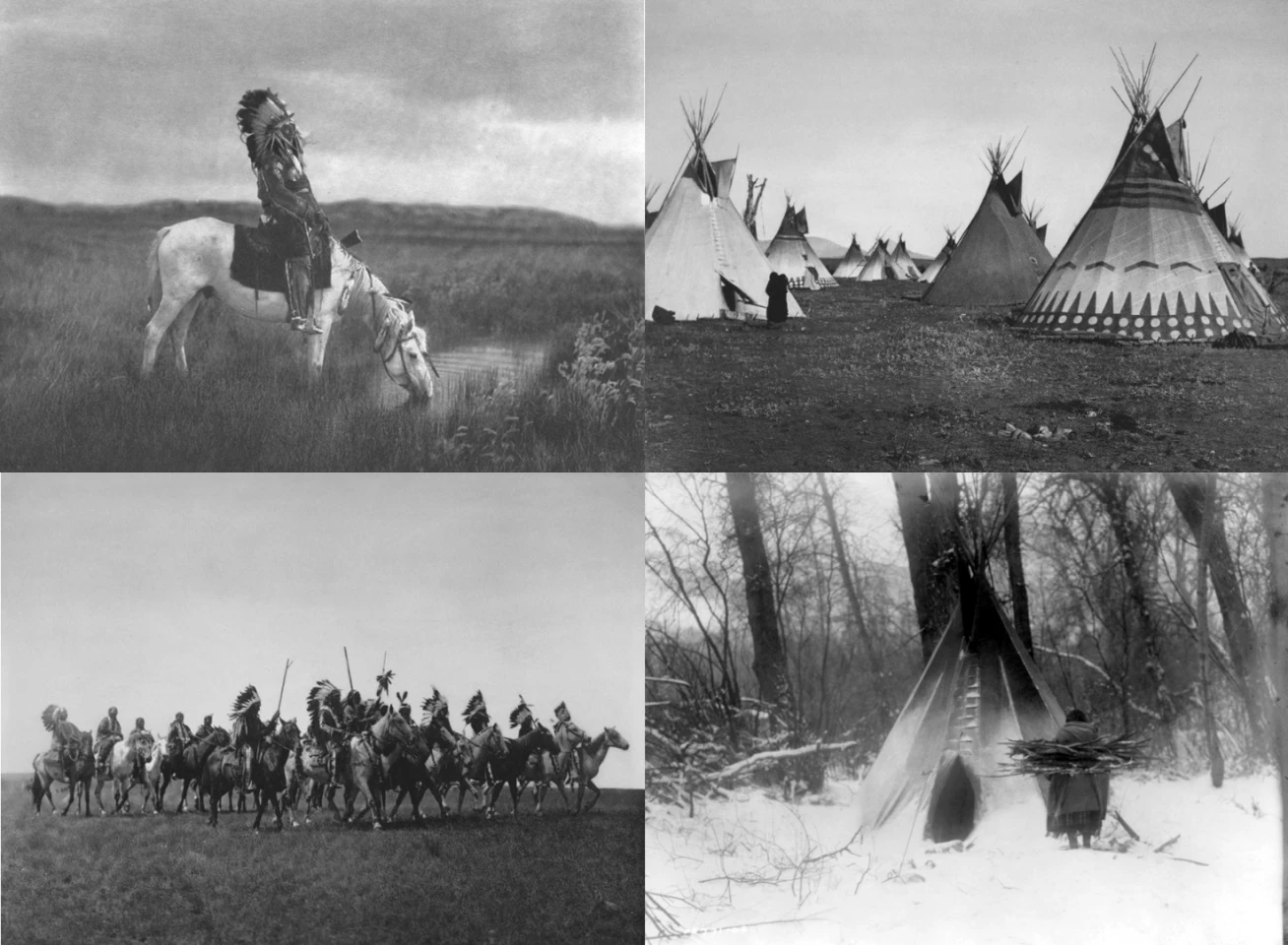
Some perspective on the price: Several other sets of the NAI have sold for significant amounts, being a set which went for $1,440,000 at a Swann Galleries auction in October, 2012, a set which fetched $1,416,000 at a Christie's auction in October, 2005, and a set sold for $1,048,000 at a Swann Galleries auction in October, 2007.
Despite representing one of the greatest achievements in the history of the United States, the record price for a set has been deemed by the marketplace to be worth less than the $3,207,852 paid for the most expensive American comic book of all time (Action Comics #1 published in June, 1938, the first appearance of Superman), Mark McGwire's 70th Home Run Ball (1998 – $3,005,000), the Cowardly Lion Costume from the 1939 movie The Wizard of Oz ($3,077,000) and only marginally more than the world's most expensive baseball card (the 1909 Honus Wagner T206 – $2,800,000). Nine American coins have sold for more than this 40 volume set.
8 – Philosophiae Naturalis Principia Mathematica by Sir Isaac Newton
Price: $3,719,500
Estimate: $1,000,000 — $1,500,000
Created: Isaac Newton composed Principia Mathematica during 1685 and 1686. It was published on 5 July 1687.
Auctioned: Christies (New York), December, 2016
This is the highest price yet paid for a first edition of Newton's Philosophiae Naturalis Principia Mathematica, the foundation work of modern science.
There may be more beautiful books, with astonishing writing, caligraphy, illustration, photography and craftsman, but no one single published body of work has ever had the impact upon the world that this book did. Principia and Opticks both became cornerstones of scientific thought. Isaac Newton (1642-1727) was knighted in 1705 by Queen Anne, but there have been many people knighted for far less justification. Newton's Philosophiae naturalis principia mathematica was the culmination of the scientific revolution, effectively ushering in the era of modern science and modern physics with its mathematical explanations for gravity and motion. Albert Einstein best summed it up with the words, "perhaps the greatest intellectual stride that it has ever been granted to any man to make."
Some perspective on the price: The auctioned copy was one of the original first printing of just 300-400 copies in Latin, of which roughly 150 copies are known to still exist. Only one other copy of Newton's Principia bound in contemporary morocco has sold at auction in the past 50 years, being the presentation copy to King James II, which was sold by Christie's (New York) in December 2013 for $2,517,000 and held the record until this auction.
Whilst this copy of Principia is the most valuable to have reached auction, an original autograph manuscript still exists with handwritten corrections and notes by Newton and Halley from 1687, along with the marginal smudges and inky fingerprints of the compositors who crafted the first print edition we see here. It is the Royal Society's greatest treasure. Newton's copious notes, like those of Leonardo da Vinci, have somehow survived to bear testimony to the first principal nature of their genius.
7 - Cosmographia by Claudius Ptolemaeus (Ptolomy)

Price: $3,966,804 (£2,139,000)
Estimate: £800,000 — £1,000,000
Created: Printed 1477, but created by Ptolomy in 150 AD
Auctioned: Sotheby's (London), October, 2006
Significance: Claudius Ptolemy (AD 100 – c. 170) was a Greco-Egyptian writer, mathematician, astronomer, geographer, astrologer, and poet who created Cosmographia (also known as Geography and Geographia) whilst living in Alexandria (Egypt) in AD 150, based on a now-lost atlas by Marinus of Tyre using additional Roman and Persian information and principles. It was translated into Arabic in the 9th century and Latin in 1406, becoming the world's first printed atlas in 1477. Only 31 copies of this book are known to still exist, and this copy is one of just two in private hands. This copy was sold as part of the Sotheby's sale of the library of Lord Wardington on October 10, 2006 and originally came from the library of Hieronymus Münzer (1437–1508), humanist, physician, and geographer.
Lord Wardington wrote of the Cosmographia: Imagine the wonderment of someone looking at a map for the first time! For these maps are the first ever printed, and for most people at that time they would have been the first maps that they had ever seen. This is the first atlas ever published... as such this book is therefore of the first importance in the field of geography, science and all the graphic arts. Today, what is not generally realized is that maps, hitherto nearly always treated as utilitarian pieces of paper, were at this time and always have been, works of art in the technique of engraving, having as they do elaborate decoration of many kinds, and magnificent calligraphy... Nor is it generally fully appreciated that up to the publication of this atlas all maps had been original manuscripts, or copies of those manuscripts, and laziness on the part of the copier, or illegibility due to use often caused inaccuracies. But with the printing of maps, scholars of all nationalities could compare and revise, and this led immediately to a very considerable advance in geographical knowledge ...
Some perspective on the price: Other (later) printed copies of Cosmographia have sold for $1,267,500 at a Sotheby's auction in June, 1998, $778,803 (£506,500) at a Sotheby's auction in November, 2014 and $725,000 at a Christies auction in April, 2016.

Despite its significant place in history and as a catalyst for global discovery (Christopher Columbus used these maps in his voyage to discover the New World), if it were an automobile, its auctioned price of $3,966,804 would not see it in our top 100 most valuable cars listing. If it were a wristwatch, it would not get a place in the top 10 most valuable wristwatches ever sold. It also failed to reach the auction prices achieved by Audrey Hepburn's Ascot dress from the feature film My Fair Lady ($4,400,000 - above left), The Maltese Falcon from the movie of the same name ($4,085,000 for the lead movie prop which was made from lead - second from right), Babe Ruth's 1920 Baseball Jersey ($4,415,658 - above right) or James Naismith's Founding Rules of Basketball written in 1891 ($4,338,500 - below left).
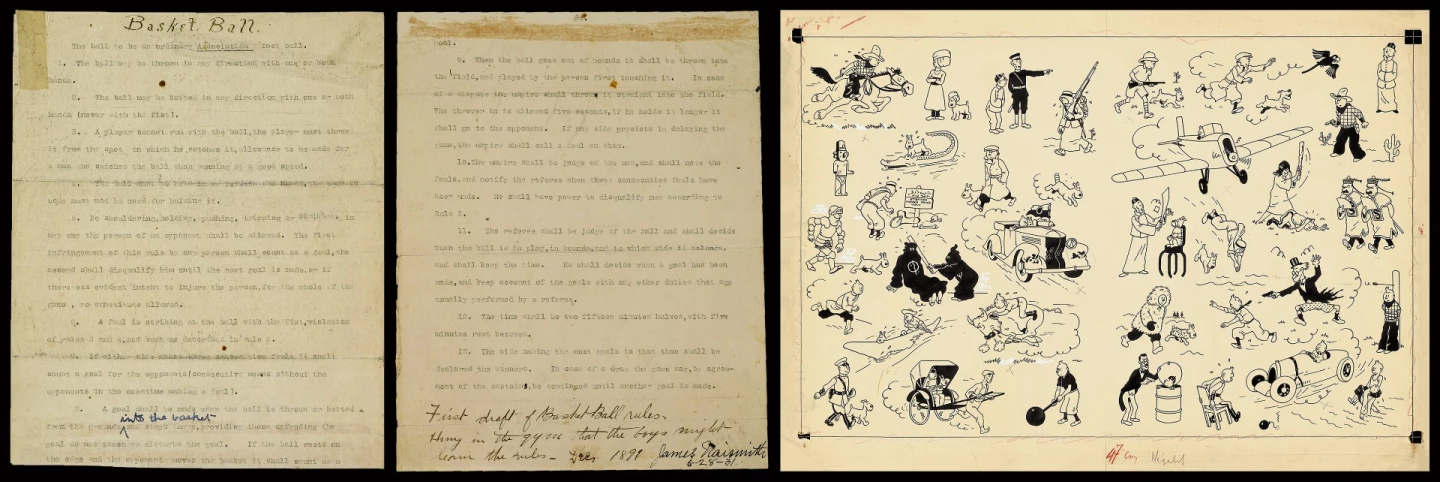
The marketplace deemed it slightly more valuable than Beethoven's handwritten manuscript of his Ninth Symphony ($3,481,991 – £2,130,000 - second from left in above image) and the world's most expensive comic book art, De Garde Bleu ($3,618,566 – €2,654,400), one of Hergé's Adventures of TinTin (above right).
6 - Traité des Arbres Fruitiers by Henri-Louis Duhamel du Monceau
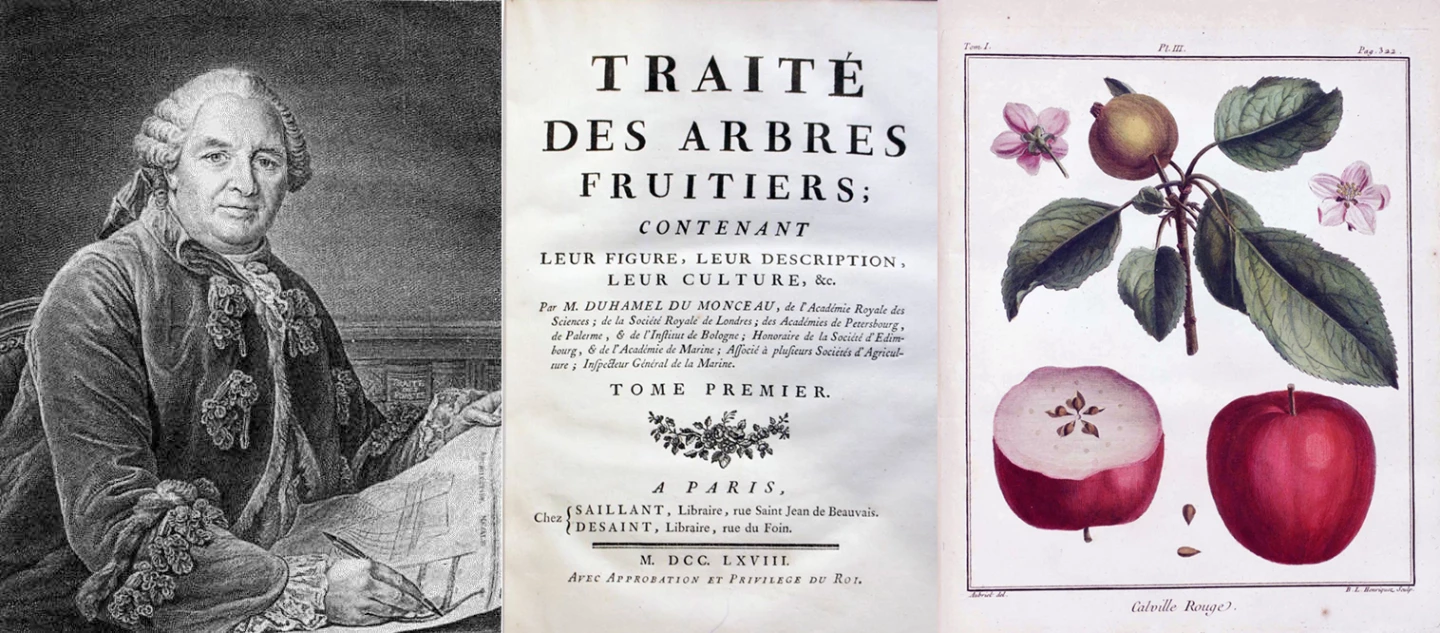
Price: $4,500,000
Estimate: not available
Created: 1768
Auctioned: Pierre Berge & Associes (Paris), 2006 (no auction link)
Significance: Henri-Louis Duhamel du Monceau (1700-1782) was an extraordinary individual whose diverse talents enabled him to conquer many fields of endeavor. Born into a wealthy farming family in France, he was educated in Law at Orleans University, then studied at the Jardin des Plantes, where he discovered the fungus disease affecting the saffron crocus, an important cash crop of the era. This work gained him membership in the prestigious Academie des Sciences and he went on to study trees, especially fruit trees, and wrote many works regarding different aspects of tree cultivation.
In 1731, he was appointed as Inspector General of the French Navy, where his work on boat building and rope making maritime subjects. His interests were united in attempts to grow trees that would provide the very best material for boat construction.
His interests were many and one of his other works, L'Art de l'Épinglier (The Art of the Pin-Maker, 1761), raised the concept of the "division of labour" which is believed to have inspired Adam Smith's landmark 1776 treatise, An Inquiry into the Nature and Causes of the Wealth of Nations.
The full publication is available at the Oak Spring Garden Library of Rare Books.

Some perspective on the price: Sitting between the sixth and seventh most expensive scientific documents in history is the most expensive manuscript by a contemporary author - J. K. Rowling's The Tales of Beedle the Bard, which sold for $3,976,103 (£1,950,000) at a Sotheby's London auction in December, 2007.

Also in this price range are two Patek Philippe Calibre 89 Pocket Watches which both sold for more than $5 million, one in yellow gold for CHF5,120,000 ($5,059,789 - above left) at an Antiquorum (Geneva) auction in November, 2009 and one in white gold for CHF6,603,500 ($5,034,290 - above right)) at an Antiquorum (Geneva) auction in April, 2004. The world's most complicated watch from 1933 until 1989 was the Patek Philippe Graves Supercomplication with 24 functions (see below). Then, in 1989 to celebrate the company's 150th Anniversary, Patek Philippe produced this watch which has 33 complications and just four were made; one each in white gold (above right), yellow gold (above left showing front and back), rose gold and platinum. The Calibre 89 was recently superseded as the world's most complex watch.
5 - Les Liliacées by Pierre-Joseph Redouté

Price: $5,500,000
Estimate: not available
Created: 1802-1816
Auctioned: Sotheby's (New York), November, 1985 (no auction link)
Significance: Pierre-Joseph Redouté (pictured above left - 1759 – 1840) was a painter and botanist known for his watercolors of flowers. He has been called "the Raphael of flowers" and "the greatest botanical illustrator of all time."
Les Liliacées was produced under the patronage of Empress Josephine of France (the wife of Napoleon I – pictured above center) though prior to the French Revolution, he had been an official court artist of Queen Marie Antoinette of "Qu'ils mangent de la brioche" fame. Provenance is always one of the key factors in determining the price of an object at auction, and with three of history's most recognizable figures associated with this magnificent work, it's not surprising it would become one of the most valuable ever. This particular set of books was Empress Josephine's personal copy from her library at Malmaison. Comprising 468 watercolors of flowers from the gardens of Malmaison, St.-Cloud, Versailles and Sevres, the 16 volume set weighs 320 pounds. The sale consisted of just one bid ($5 million plus the buyer's premium of 10%) which stunned the crowd into submission. The prize went to a syndicate run by rare book dealer W. Graham Arader .
The New York Public Library's Digital Collection offers a complete digital reproduction of this book, as does the Biodiversity Library.

Some perspective on the price: Other items to sell at auction in this price range include a Gutenberg Bible ($5,390,000 - the first major book printed using mass-produced movable type), a leaf from a Qur'an ($4,892,483 - £2,484,50 - one of the earliest fragments of the Qur'an ever produced dating from the middle of the 7th Century), the dress from the movie The Seven Year Itch worn by Marilyn Monroe over the subway grate ($5,520,000 - above left), a Copper Indian Chief Weathervane ($5,840,000 - circa 1900 - above right) and the most expensive non-US coin ever sold at auction, a Umayyad Caliphate gold dinar struck in the first year of rule of Caliph Hisham ibn Abd al-Malik (723 - 724 AD., A.H.105).

Bestiaries (a compendium of descriptions and images of real and imaginary animals intended to provide readers with moral lessons) became popular in the Middle Ages. The Northumberland Bestiary was purchased in 1990 by the J. Paul Getty Museum in Los Angeles and can now be explored in detail online. We didn't give it official scientific manuscript status because Bestiaries used the representations of animals to explain their significance within religious context. It is almost a scientific document given its time, and a quite fascinating exercise demonstrating humanity's unfathomable capacity to suspend disbelief, but "no cigar". It sold at a Sotheby's auction in 1990 for $5,800,000.
4 - Letter from Francis Crick to his son revealing the discovery of the structure of deoxyribonucleic acid (DNA) - the building block of life

Price: $6,059,750
Estimate: $1,000,000 - $2,000,000
Created: 19 March, 1953
Auctioned: Christie's (New York), April, 2013
Significance: Francis Crick (1916-2004) was a British physicist who at 31 years of age moved his academic field of endeavor to the study of biology. Six years later, he would make one of the landmark scientific breakthroughs. With Crick (pictured right above) working alongside James Watson (pictured left above), and building upon the work of Maurice Wilkins, Rosalind Franklin and others, the pair finally decoded the structure of deoxyribonucleic acid (DNA) on Saturday, 28 February, 1953. Later that afternoon, Crick would announce to the patrons of the Eagle Pub in Cambridge (U.K.), "we have discovered the secret of life." The work would be disclosed to the world in the form of two papers published in the journal Nature, in April and May, 1953.
This letter, from Crick to his twelve-year-old son Michael is dated 19 March, 1953, a full month prior to the release of the issue of Nature.
It reads in part: "Dear Michael, Jim Watson and I have probably made a most important discovery. We have built a model for the structure of des-oxy-ribose-nucleic-acid (read it carefully) called D.N.A. You may remember that the genes of the chromosomes - which carry the hereditary factors - are made up of protein and D.N.A. Our structure is very beautiful." He goes on to describe the structure in detail including its helical shape with his hand drawn diagram: "Now we have two of these chains winding round each other - each one is a helix - and the chain, made up of sugar and phosphorus, is on the outside, and the bases are all on the inside. I can't draw it very well, but it looks like this" Crick lays out the fixed base pairings which he describes as being like a code: "If you are given one set of letters you can write down the others. "Now we believe that the D.N.A. is a code. That is, the order of the bases (the letters) makes one gene different from another gene (just as one page of print is different from another). You can now see how Nature makes copies of the genes. Because if the two chains unwind into two separate chains, and if each chain then makes another chain come together on it, then because A always goes with T, and G with C, we shall get two copies where we had one before." After a series of diagrams of the base pairings, he modestly continues: "In other words we think we have found the basic copying mechanism by which life comes from life." Referring to publication of the discovery, Crick informs he son: "You can understand that we are very excited. We have to have a letter off to Nature in a day or so" and instructs him "Read this carefully so that you understand it. When you come home we will show you the model. Lots of love, Daddy."
There's an excellent digital encyclopedia about DNA available at DNA from the beginning.
Some perspective on price: First folio works of two of the English language's best known writers have both exceeded Crick's letter at auction: The Canterbury Tales by Geoffrey Chaucer ($7,563,965 - £4,621,500 - circa 1477) and Comedies, Histories & Tragedies by William Shakespeare ($6,166,000 - printed 1623).
3 - The Theory of Relativity by Albert Einstein
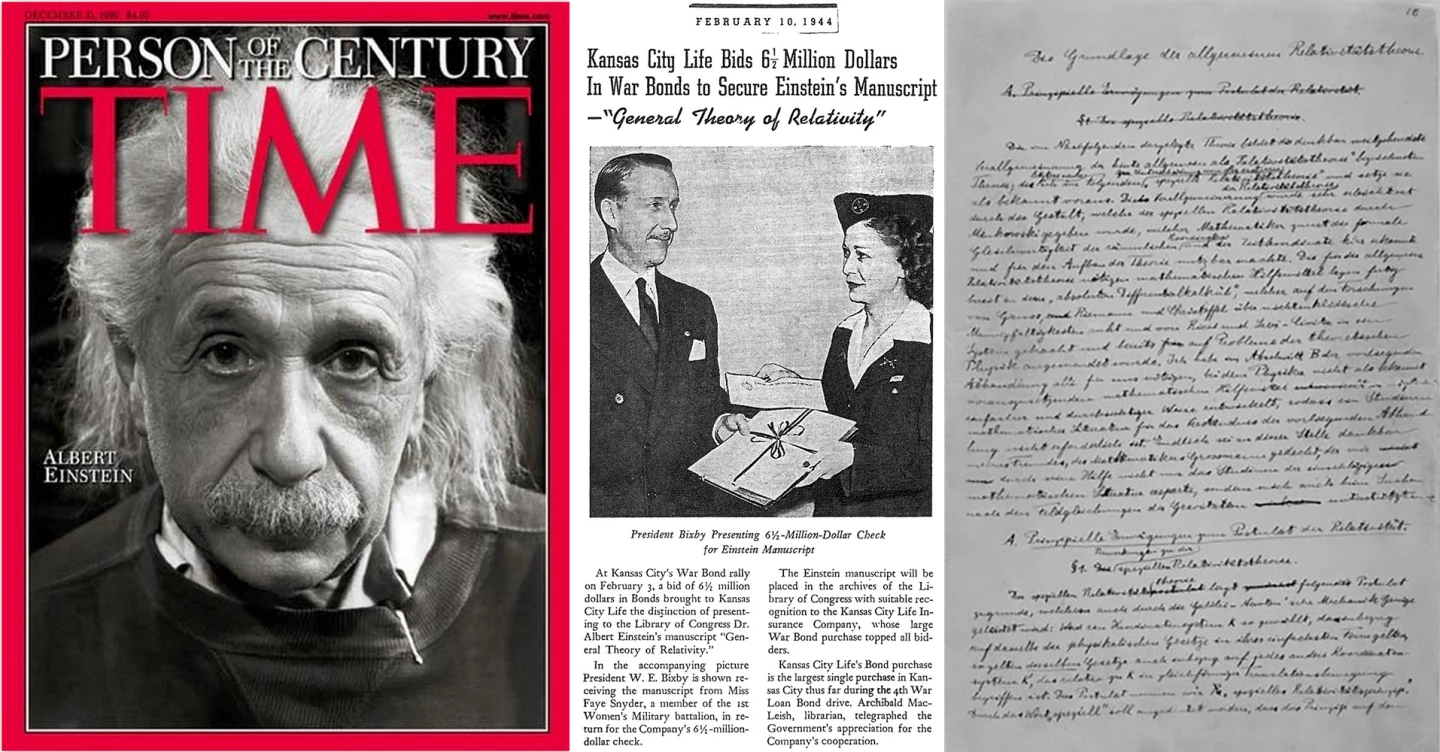
Price: $6,500,000
Created: Originally written 1905, but rewritten by Einstein in 1943 to raise funds for the American war effort
Auctioned: Kansas City Women's Club (Kansas City), 1944
Significance: Our research for this listing has found more than a dozen Einstein manuscripts sold at auction, and there are eight in the top 100 but this one almost slipped through the cracks despite Einstein's mantle as science's rock star.
We covered Einstein's remarkable record on the auction block when his leather jacket went to auction earlier this year, and again when his childhood building blocks and pocket watch broke auction records.
Einstein's image represents the epitome of genius, and it is being used in advertising across the globe in many different ways. The gentle, kind, thoughtful and humble Albert Einstein is currently in Forbes magazine's top money-earning deceased celebrities.
In 2015, Albert Einstein entered Time magazine's list at number 6, just behind Marilyn Monroe, Elizabeth Taylor and John Lennon. He's an unlikely candidate for most charismatic personal brand of all time, given he rarely spoke in public, and wasn't in film, TV, entertainment or sport, but that's the league he's now playing in six decades after his death. By all available measures, Albert Einstein has become one of the strongest personal brand names in history.
Time Magazine's "Person of the Century" threw out the original hand-written manuscript of his Theory of Relativity when the paper was published in 1905, but made another hand-written copy in 1943 to raise money for the war effort and it was purchased at a 1944 auction by the Kansas City Life Insurance Company for $6.5 million (an astonishing amount at the time), which then donated the manuscript to the US Library of Congress.
2 - The Birds of America by John James Audubon
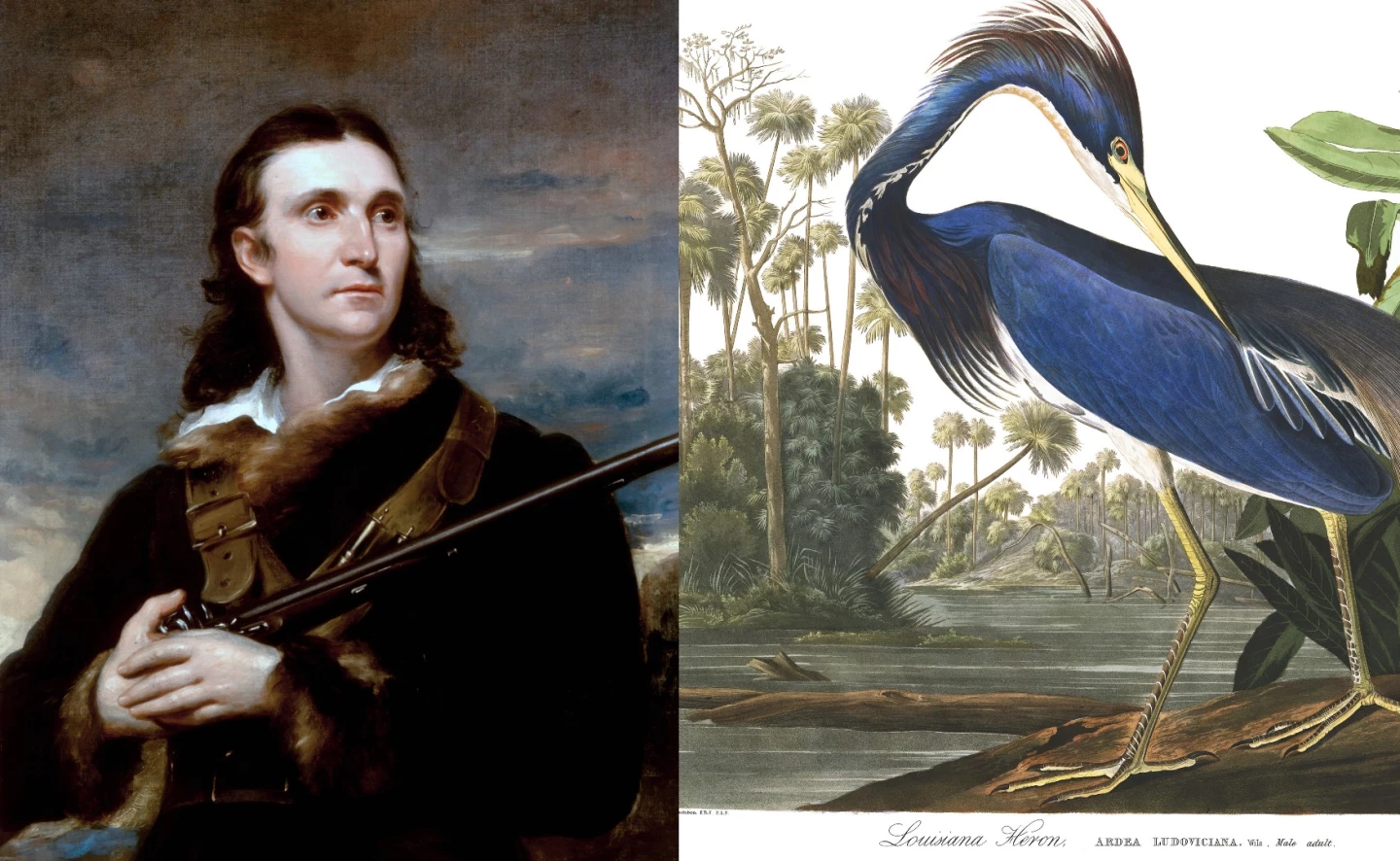
Price: $11,570,496 (£7,321,250)
Estimate: £4,000,000 — £6,000,000
Created: 1827-1838
Auctioned: Sotheby's (London), December, 2010
Significance: The Birds of America is a book by Franco-American ornithologist, naturalist and artist John James Audubon (1785 – 1851), first published as an irregular series between 1827 and 1838. Audubon painted, cataloged, and described the birds of North America in their natural environments in this quite unique book and his name lives on through the American National Audubon Society, a non-profit environmental organization dedicated to conservation.
Fewer than 200 sets of the original "elephant edition" (a reference to its size of 99 cm by 66 cm - yes, the book stands a meter tall) were published, containing 435 life-sized watercolors of North American birds and this astonishingly beautiful work is now reproduced digitally on the Audubon site for all to behold. Reproduction editions of the books in "baby elephant" format are also available, and given that this book would constitute the majority of the top 10 scientific documents ever sold if we counted the multiple copies that have achieved astronomical prices, the $185 price makes an ideal gift for conservationists and bird lovers. Highly recommended.
There are nearly 100 recorded auction sales of bound volumes of Birds of America for prices in excess of $100,000 and seven auction sales in excess of US$3,000,000. Other than this sale, those prices for Birds of America include $8,802,500 by Christie's in March, 2000, $7,922,500 by Christie's in January, 2012, $5,616,000 by Christie's in December, 2005, $3,525,000 by Sotheby's in April, 2014, $3,043,040 (£1,760,000) by Sotheby's in June, 1990 and $3,027,500 by Christie's in October, 1993.

Some perspective on the price: The second most expensive scientific document in history has been comfortably exceeded at auction by four religious texts: The Saint Cuthbert Gospel by St Cuthbert, Bishop of Lindisfarne (US$14,461,777 - £9,000,000, the oldest intact book in Europe from circa 687), The Bay Psalm Book (US$14,165,000 - from 1640), The Rothschild Prayerbook ($13,605,000 - circa 1610) and The Gospels of Henry the Lion (created in 1107 by the Order of St. Benedict – sold for $11,700,000 in 1983 so there's no auction link).
It also sold for less than half the price of the world's most valuable watch, the Patek Philippe Graves Supercomplication Pocket Watch, which sold for US$24,052,309 (CHF23,237,000) at a Sotheby's (Geneva) auction in November, 2014. Made by Patek Philippe for New York banker Henry Graves Jr., it was the coup de grace in an informal competition with automaker James Ward Packard to own the most complicated watch in the world. Beginning in 1925, the Swiss watchmaking firm spent three years of research and five years of bench work before finally delivering the watch to Graves in 1933.
Given the capabilities of this pocket watch, it is arguably the world's most expensive scientific instrument ever sold at auction too. Think of this watch as an analog iPhone created 80 years ago. There are two faces (front and back) and 24 complications, including a perpetual calendar good until 2100, a moon dial, a sidereal time dial, power reserve indicator, sunrise and sunset times, a night sky map set for New York, and Westminster chimes to mark the passage of time. Perhaps the most remarkable aspect of the watch is that if you could actually use it as a pseudo GPS, though perhaps without the same accuracy as the iPhone. See our auction report for the back story.
1 - "The Codex Leicester" by Leonardo da Vinci

Price: $30,802,500
Estimate: $12,000,000 - $18,000,000
Created: 1506 -1513
Auctioned: Christie's (New York), November, 1994
Significance: Firstly, let's clear up the nomenclature - there are at least 20 notebooks and more than of 13,000 pages of Leonardo da Vinci's notes still in existence with significant holdings by the Royal Library at Windsor Castle (UK), the Louvre (France), the Biblioteca Nacional de España (Spain), the Victoria and Albert Museum (UK), the Biblioteca Ambrosiana (in Milan, Italy which holds the equally well-known and much larger Codex Atlanticus) and the British Library.
The "Codex Leicester" was named after Thomas Coke, later created Earl of Leicester, who purchased it in Italy in 1717. Leonardo had bequeathed the Codex to his friend Francesco Melzi and it then passed into the hands of sculptor Guglielmo della Porta, surfacing publicly from della Porta's family estate in 1690. In 1980, the Codex was purchased from the Leicester estate at a London Christie's auction for $5.6 million by Armand Hammer, and for a time was known as the Hammer Codex. Hammer died in 1990 and the collection was left to the Armand Hammer Museum of Art & Cultural Center at the University of California. The world record price for any book or manuscript of US$30.8 million was achieved at a Christie's auction in New York on 11 November, 1994, when it was purchased by Microsoft founder Bill Gates. Curiously, despite Gates being the world's best known and greatest ever philanthropist on so many levels, it has not been known as the Gates Codex, but continues to be referred to as either the Codex Leicester or Hammer Codex. The codex is hence both the most expensive scientific document and the most expensive book ever sold, and is the only major Leonardo manuscript in private hands.
Leonardo da Vinci (1452 – 1519) is regarded by many as the most diversely talented human to have lived, and the term "Renaissance Man" was coined with Leonardo's unequaled polymath credentials in mind. Though best known as one of the greatest painters in history, a study of Leonardo's numerous writings leaves little doubt of an inventiveness that knew no bounds and he made significant contributions in the fields of architecture, science, music, mathematics, engineering, anatomy, geology, astronomy, botany and cartography. His inventions, such as the parachute, helicopter and armored tank, were sometimes centuries ahead of their time.
Click on the above file and take a closer look and you'll see that the entire document appears to have been mistakenly reversed in Photoshop - not so, as Leonardo wrote mainly in mirror writing, and no-one is quite sure why.

Some perspective on the price: The head of the world's largest classic auto insurance company and a respected industry commentator, McKeel Hagerty, recently referred to the Ferrari 335S Spider Scaglietti that sold for US$35.7 million in February 2016 as a "Mona Lisa Car". That's the 335S above at the moment the hammer fell - we calculate all our prices by adding in the buyer's premium and using the historical exchange rates for the day of each sale, we convert to American dollars. America has more Ultra High Net Worth (UHNW) individuals than any other country and is the global heart of the auction industry.
Now I'm presuming Hagerty's "Mona Lisa" reference means a car that is extremely rare, exquisitely beautiful, has a fabled history and an impeccable provenance. Three "Mona Lisa" cars have sold in recent times: the aforementioned Ferrari, a 1962 Ferrari 250 GTO in August, 2014 that fetched $38.1 million and Juan Manuel Fangio's 1954 Mercedes-Benz W196 Silver Arrow which fetched $29.6 million in July, 2013.
Ferrari made just four 335S race cars 59 years ago, Mercedes-Benz made 14 W196 Silver Arrows (10 extant) 62 years ago, and 39 Ferrari 250 GTOs were made around 55 years ago. There is some irony that two of these cars sold for more than a notebook written 500 years ago by the same hand that actually created the real Mona Lisa (not to mention The Last Supper and Vitruvian Man) that McKeel cites ... and there's only one of these.
Finally, in order to fully appreciate the strengths of various collectible marketplaces and the world's perceived value of Leonardo's codex, what follows are the highest prices ever paid at auction for artworks, antiquities, violins, sculpture, photographs and furniture.

Les Femmes d'Alger (Women of Algiers) is a series of 15 paintings and numerous drawings by Spanish cubist artist Pablo Picasso. The entire series was purchased by Victor and Sally Ganz from the Galerie Louise Leiris in Paris for $212,500 in June 1956. Ten paintings from the series were later sold by the Ganz's to the Saidenberg Gallery, with the couple keeping five. The final painting in the series, was painted in 1955 and sold by Christie's (New York) for $31.9 million in November 1997, as part of the Ganz collection. Christies (New York) again auctioned the painting (above top left) in May 2015, fetching US$179,365,000 which is the current world record price for a painting at auction. The most expensive work of art to previously sell at auction, was Francis Bacon's painting Three Studies of Lucian Freud, which fetched $142,405,000 in 2013.
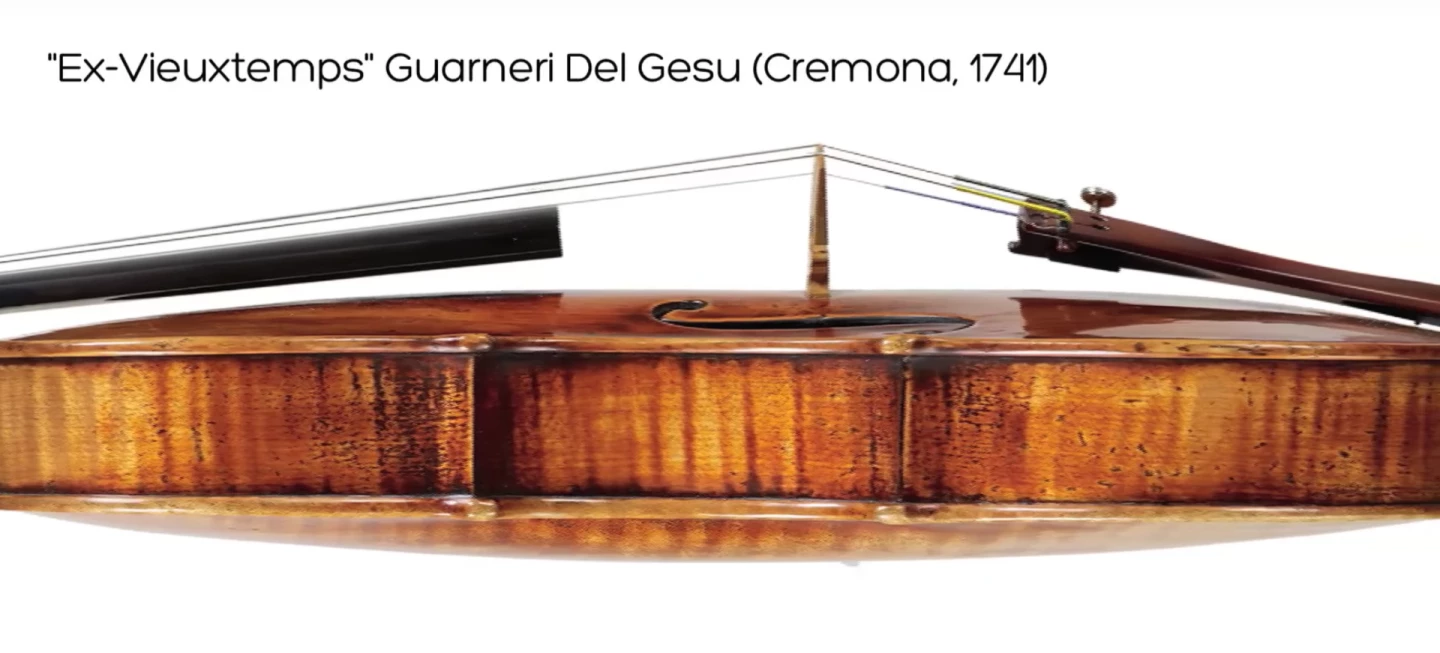
In 2010, London banker Ian Stoutzker paid US$18,000,000+ for the legendary 1741 "Vieuxtemps" Guarneri del Gesu (above) at a Bein & Fushi auction, sometimes referred to as "the Mona Lisa of violins." In a truly extraordinary act, instead of putting it in museum or locking it in a bank vault, Stoutzker then awarded "lifetime use" of the instrument to violin prodigy Anne Akiko Meyers. The world has subsequently been able to witness the exquisite sound of the instrument in concert.The old saying "they don't make them like they used to" applies more to violins than any other collectible because although almost any level of craftsmanship can be replicated, albeit with great cost, the wood with which the most famous violins were produced is no longer available.If you have any doubt that the Vieuxtemps Guarneri del Gesu is something very special indeed, watch this YouTube video of Anne Akiko Meyers playing the Vieuxtemps in its Carnegie Hall debut with the Orpheus Chamber Orchestra.
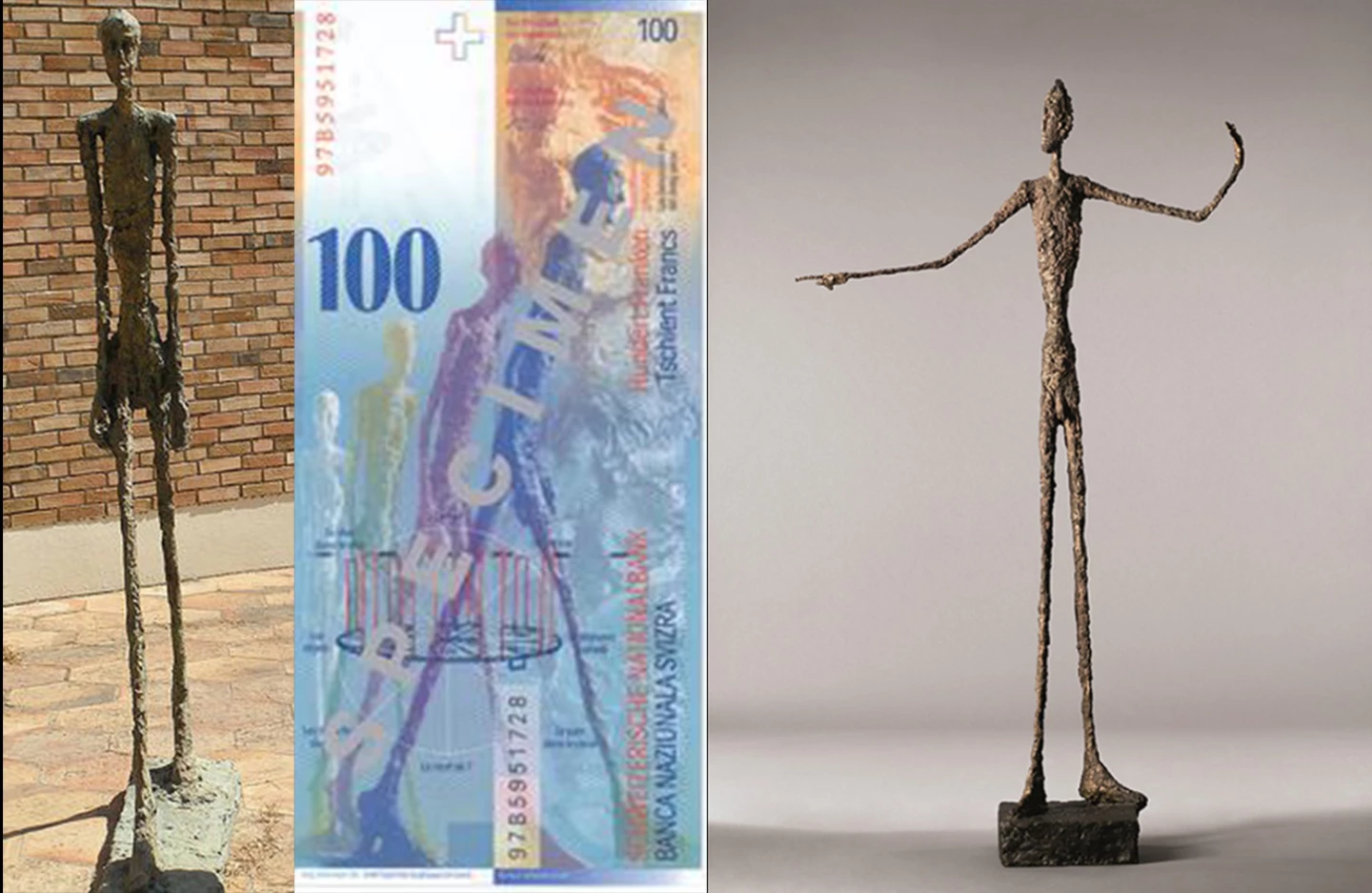
The most expensive sculpture ever sold at auction the work of Alberto Giacometti (1901-1966) as is the second. In May 2015 Christies sold L'homme au doigt for US$141,285,000 to become the most expensive sculpture in history, eclipsing L'Homme qui marche I which sold for £65,001,250 (US$102,006,465) at Sotheby's in February 2010.

The most expensive artwork from antiquity is the Guennol Lioness (left), a 5,000-year-old Mesopotamian statue that sold for $57,161,000 at Sotheby's in December 2007. The previous record holder was the 1st century CE figure of Artemis and the Stag, which sold for US$28,600,000 at a Sotheby's auction in June 2007.
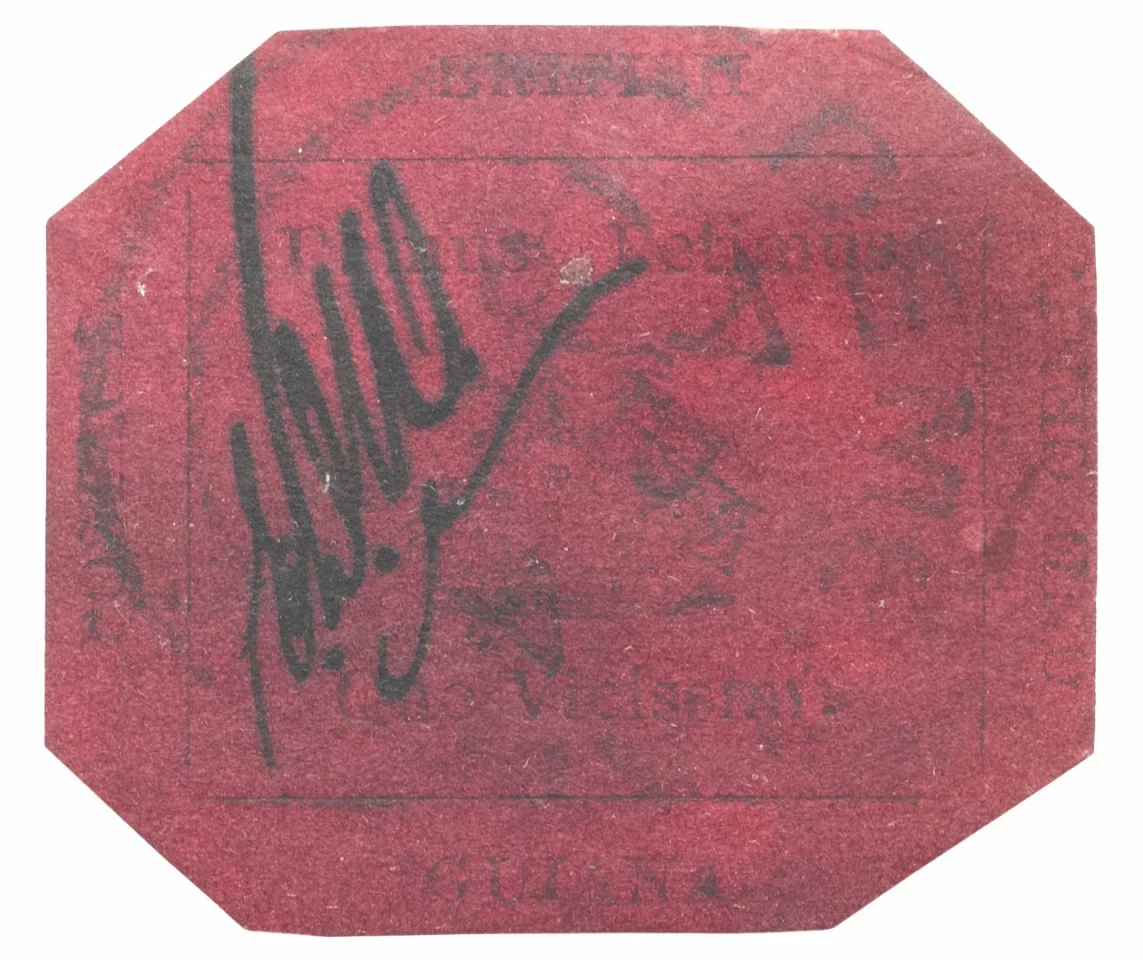
The original collectors' treasure was the postage stamp, and although email has largely replaced snail mail, that marketplace has not slowed. There's only one "1856 British Guiana 1c Magenta," but clearly there's still quite a strong market for philately as the famous stamp from the former British colony (since 1966 the independent nation of Guyana) sold for US$9,480,000 in June (2014), making it the world's most valuable postage stamp and coincidentally, the world's most valuable object by weight. In the 1920s, the only known 1856 British Guiana 1c Magenta, pictured above, was owned by US industrialist Arthur Hind. When a second example surfaced, Hind paid a vast sum to buy the second stamp, then set fire to it with his cigar, famously exclaiming: "I still own the world's rarest stamp!" Chemicals fortune heir and well known collector John du Pont (the subject of the 2014 movie Foxcatcher) paid US$935,000 for this stamp in 1980 and it had been locked in a humidified bank vault for the last third of a century prior to its Sotheby's auction in June (2014).

The world record price at auction for a photograph Rhein II, taken in 1999 by Andreas Gursky. A print measuring 73 by 143 inches (190 cm × 360 cm) sold for US$4,338,500 at a Christie's auction in November, 2011.
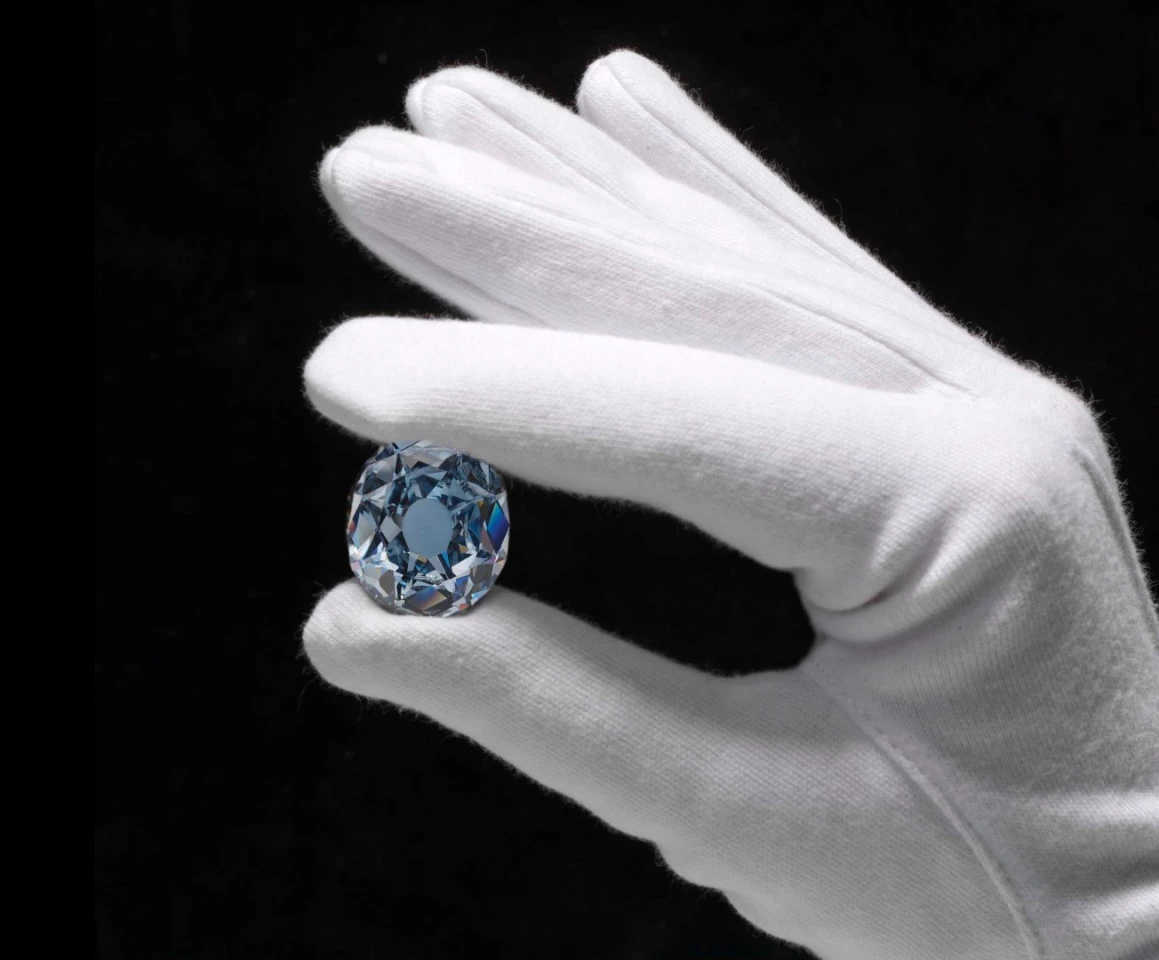
The world's most expensive jewel sold at auction is the 35.56-carat blue Wittelsbach-Graff Diamond was first noted by history in the possession of the Habsburg family in Vienna (Austria) in 1722, subsequently passing through Austrian and Bavarian royalty until World War I when Bavaria became a republic and the jewel became state property. Christie's auctioned the diamond in 1931 but bidding did not reach reserve. In 2008, it sold for $23.4 million at a Christie's auction.
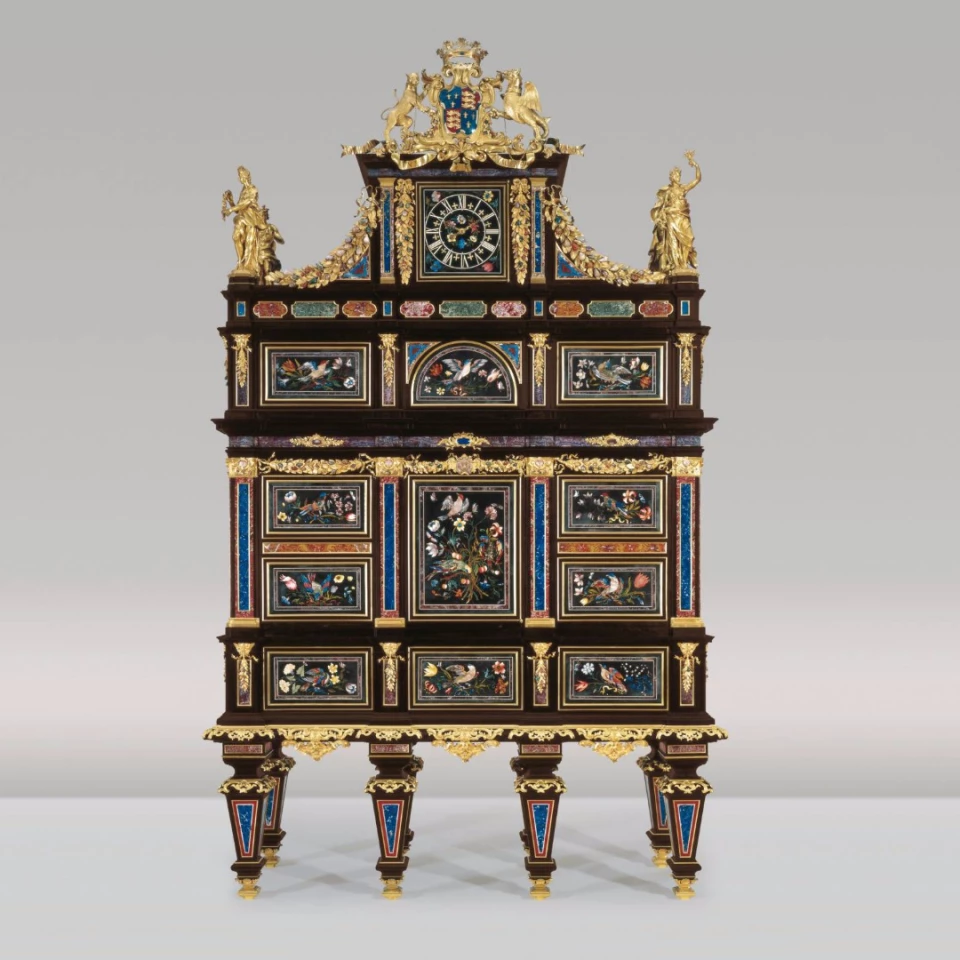
The most expensive piece of furniture ever sold was this magnificent florentine pietra dura, ebony and ormolu cabinet made for the 3rd Duke of Beaufortby the Grand Ducal workshops (Galleria dei Lavori) and Baccio Cappelli, the bronze figures of the four seasons by Girolamo Ticciati, circa 1720-1732. Christies sold the most expensive piece of furniture in the world for US$36,514,611 (£19,045,250) in December, 2004.

One of the first contemporary collectibles were the cigarette cards which were used to market tobacco in the late eighteenth and nineteenth century. The world's most expensive baseball card is the T206 Honus Wagner. The Honus Wagner card has been the rarest and most expensive baseball card in the world since it was listed in Jefferson Burdick's The American Card Catalog (1933) at a value of US$50 during the great depression.
The original card was withdrawn prior to circulation because Wagner, a non-smoker, threatened legal action against the tobacco company which had planned to use his image on a cigarette card without his permission. With such an active marketplace of card collectors, and just 57 Honus Wagner cards known to still exist, the laws of supply and demand have driven the card to astonishing prices.
Explore parts 1-5 of our journey through the most valuable scientific documents of all-time here.
